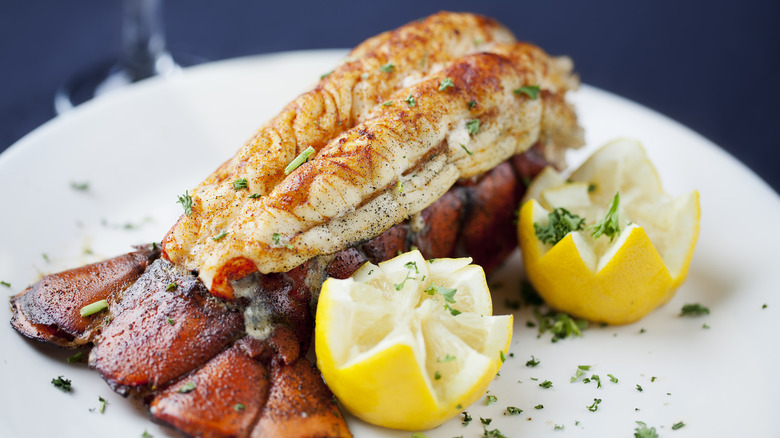Here's The Right Way To Properly Butterfly A Delicate Lobster Tail
Lobster tails are a year-round delicacy that can be cooked in all manner of ways and served either as the main event or as a key ingredient. Whether you're serving grilled lobster tails or throwing them in the oven to bake, the most popular way to prepare them is butterflying — a skill you'll master by following this easy guide.
First of all, what is butterflying? In the culinary world, it means cutting something almost in half, leaving the food connected at the bottom so it splays out flat, resembling the shape of a butterfly. For lobster tails, this means cutting the crustacean down the middle yet leaving it attached at the end of the tail, then cooking it on the shell. Butterflying lobster tails may seem daunting at first, given you have to navigate their tough shells while not shredding the delicate meat inside; but with the proper tools and technique, you'll do it the right way every time.
Butterflying a lobster tail without making mistakes
Start by grabbing a sharp pair of kitchen shears and a freshly washed, uncooked lobster tail. Hold the tail with the fanned-out end facing away from you and the shell spine facing up, then cut down the center of the shell, stopping before the tail fan so the meat remains attached at the end. Don't cut all the way through the meat, just cut the top half so that the meat will spread in one big piece — like butterfly wings. Carefully lift the meat from the shell while keeping it attached to the tail fan, and close the shell halves back together under the meat, creating a makeshift platform for the tail.
People make many common mistakes when cooking and preparing lobster, such as cutting the lobster tail all the way through and creating two unattached wings instead of a whole butterfly. Another common mistake is removing the meat completely — you want to keep the meat attached to the tail at the base so it remains in the shell when cooking.
Finally, you'll need to use the right tools — and not ones for smashing claws. Stick to a pair of very sharp shears that won't tear up the tender meat or damage the shell. You can wear thick kitchen gloves to protect your hands from the shell, or hold the tails with a lint-free towel. Don't wear thin foodservice gloves though, as they may get caught on the shell and tear.
How to choose and flavor your lobster tails
Butterflied lobster tails are popular for a reason: the open surface area of the meat is prime for soaking up marinades that you simply brush on. You can prepare lobster tails with as little as melted butter and salt, but why stop there? Quick, flavorful marinades are easy to make, and you can tailor yours to lean into the sweet, buttery flavor of lobster. Olive oil pairs well with aromatics like garlic and parsley and can be livened up by a splash of white wine for acidity. Seafood also pairs well with citrus because the citric acid reacts with the salt in the fish and creates a beautifully balanced flavor — that's why dousing your lobster tails in lemon juice either before or after cooking is a crowd-pleaser.
When searching for the best lobster tails, live lobsters taste fresher than frozen so check the fish counter before heading to the frozen aisles. When it comes to lobsters, more size does not equal more flavor. Smaller tails have better flavor and texture, so keep an eye out for the little guys. If you're planning to host a larger party, have no fear, lobster tails store well in the fridge even after they've been butterflied. They'll keep up to four hours, so when the guests arrive all you have to do is brush them with a marinade and grill or broil them.


